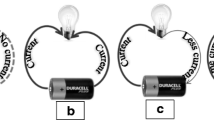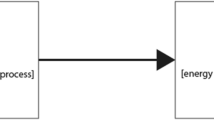Abstract
Arrows are recognized as efficient visual elements in conveying location, direction, connection, and process because the shape is thought to have an immediate, common sense impact on viewers. However, the results of our prior quantitative study did not support the assumed effects of arrows in reading energy pyramid diagrams. The current study utilized an integrated cognitive semiotics framework and a 5-phase interview to compare the interpretations of energy pyramid diagrams with or without arrows in controlled contexts. Grade 7 students (N = 18) with 3 levels of prior knowledge were randomly assigned to an experimental group (with arrows) or a control group (without arrows). Results suggested that arrows elicited more functional interpretations and confirmed that arrows could invite thematic meanings more efficiently. However, the finding that low prior knowledge participants had difficulty interpreting thematic meanings and generated misinterpretations suggests that prior knowledge plays a role in making meaning from diagrams. Considerations of the research methods and suggestions for pedagogy are discussed.








Similar content being viewed by others
References
Ainsworth, S. (2006). DeFT: A conceptual framework for considering learning with multiple representations. Learning and Instruction, 16, 183–198.
Ametller, J., & Pinto, R. (2002). Students’ reading of innovative images of energy at secondary school level. International Journal of Science Education, 24(3), 285–312.
Chen, S.-H., Fang, C.-H., Yao, H., Hsu, K.-C., & Lee, T.-Y. (2013). Science and technology 2. Tainan: Han-Lin.
Cook, M. P., Wiebe, E. N., & Carter, G. (2008). The influence of prior knowledge on viewing and interpreting graphics with macroscopic and molecular representations. Science Education, 92, 848–867.
de Koning, B. B., Tabbers, H. K., Rikers, R. M. J. P., & Paas, F. G. W. C. (2009). Towards a framework for attention cueing in instructional animations: Guidelines for research and design. Educational Psychology Review, 21(2), 113–140.
diSessa, A. A. (2004). Metarepresentation: Native competence and targets for instruction. Cognition and Instruction, 22(3), 293–331. https://doi.org/10.1207/s1532690xci2203_2.
Eilam, B. (2013). Possible constraints of visualization in biology: Challenges in learning with multiple representations. In D. F. Treagust & C.-Y. Tsui (Eds.), Multiple representations in biological education (pp. 55–74). London: Springer.
Eilam, B., & Poyas, Y. (2010). External visual representations in science learning: The case of relations among system components. International Journal of Science Education, 32(17), 2335–2366.
Ge, Y.-P., Chung, C.-H., Wang, K.-H., Chang, H.-P., & Unsworth, L. (2014). Comparing the Images in Taiwanese and Australian science textbooks by grammar of visual design: An example of biological classification. Chinese Journal of Science Education, 22, 109–134.
Ge, Y.-P., Unsworth, L., & Wang, K.-H. (2017). The effects of explicit visual cues in reading biological diagrams. International Jounal of Science Education, 39, 605–626. https://doi.org/10.1080/09500693.2017.1297549.
Ge, Y.-P., Unsworth, L., Wang, K.-H., & Chang, H.-P. (2018). Image design: Helping students build coherent meaning by explicit visual cues. In K.-S. Tang & K. Danielsson (Eds.), Global Developments in Literacy Research for Science Education (pp. 237–258). Netherlands: Springer.
Hegarty, M. (2011). The cognitive science of visual-spatial displays: Implications for design. Topics in Cognitive Science, 3, 446–474.
Heiser, J., & Tversky, B. (2006). Arrows in comprehending and producing mechanical diagrams. Cognitive Science, 30, 581–592.
Hmelo-Silver, C. E., & Azevedo, R. (2006). Understanding complex systems: Some core challenges. The Journal of the Learning Sciences, 15(1), 53–61.
Kesidou, S., & Duit, R. (1993). Students’ conceptions of the second law of thermodynamics: An interpretive study. Journal of Research in Science Teaching, 30(1), 85–106.
Kress, G., & van Leeuwen, T. (2006). Reading images: The grammar of visual design (2nd ed.). New York: Routledge.
Lee, V. R. (2010). How different variants of orbit diagrams influence student explanations of the seasons. Science Education, 94, 985–1007.
Mayer, R. E. (2003). The promise of multimedia learning: Using the same instructional design methods across different media. Learning and Instruction, 13, 125–139.
Ministry of Education. (2000). Grade 1–9 curriculum guidelines. Taipei: Author.
Schnotz, W., & Bannert, M. (2003). Construction and interference in learning from multiple representation. Learning and Instruction, 13(2), 141–156.
Seufert, T. (2003). Supporting coherence formation in learning from multiple representations. Learning and Instruction, 13(2), 227–237.
Shah, P., Hegarty, M., & Mayer, R. E. (1999). Graphs as aids to knowledge construction: Signaling techniques for guiding the process of graph comprehension. Journal of Educational Psychology, 91, 690–702.
Stylianidou, F., & Ogborn, F. (2002). Analysis of science textbook pictures about energy and pupils’ readings of them. International Journal of Science Education, 24(3), 257–283.
Tippett, C. D. (2016). What recent research on diagrams suggests about learning with rather than learning from visual representations in science. International Journal of Science Education, 38(5), 725–746. https://doi.org/10.1080/09500693.2016.1158435.
Unsworth, L. (2001). Teaching multiliteracies across the curriculum: Changing contexts of text and image in classroom practice. Philadelphia: Open University Press.
Acknowledgments
The authors wish to express great gratitude for the assistance of Dr. Larry Yore and Ms. Shari Yore for their valuable and constructive suggestions on the manuscript.
Author information
Authors and Affiliations
Corresponding author
Rights and permissions
About this article
Cite this article
Ge, YP., Yang, H. Do We Need Arrows in Representing an Energy Pyramid?. Int J of Sci and Math Educ 17, 1301–1316 (2019). https://doi.org/10.1007/s10763-018-9929-4
Received:
Accepted:
Published:
Issue Date:
DOI: https://doi.org/10.1007/s10763-018-9929-4




